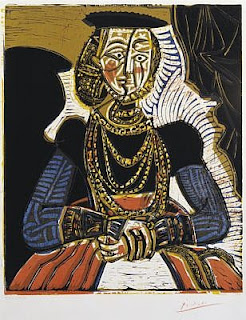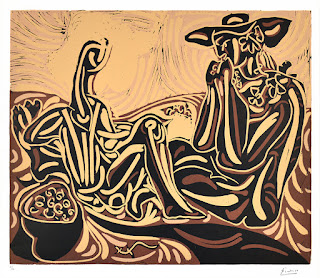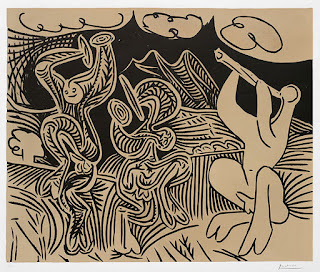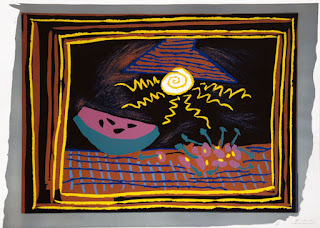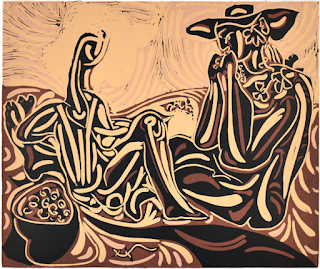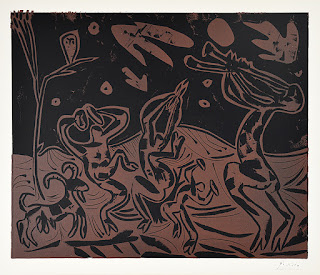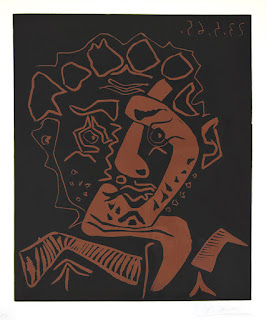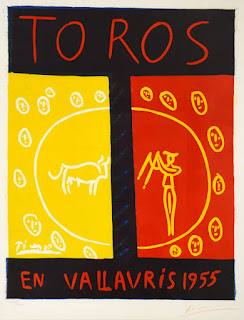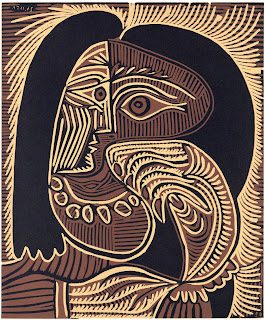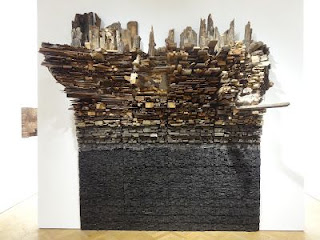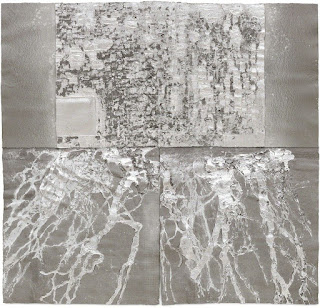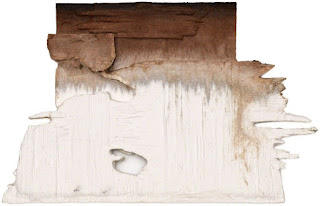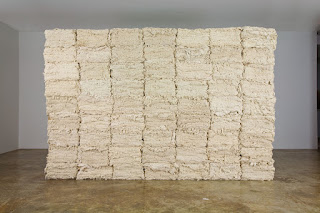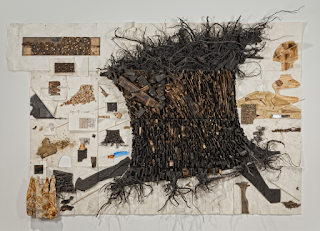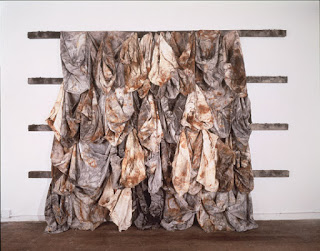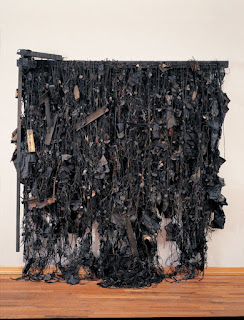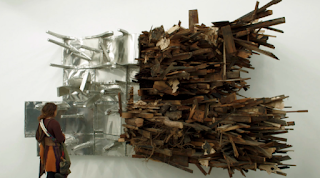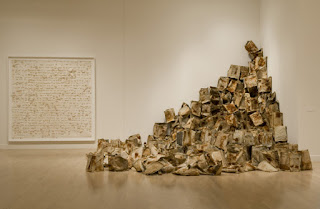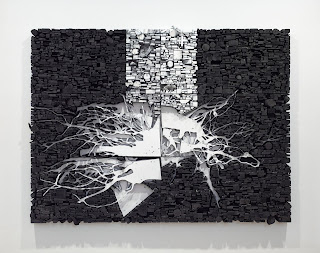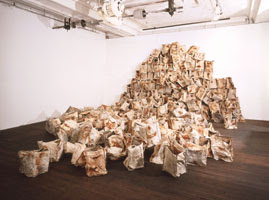Thursday, March 22, 2018
Portrait of a Woman, after Lucas Cranach
This linocut by Pablo Piscasso is called Portrait of a Woman after Lucas Cranach. I really liked this linocut because I think the use of colors it was makes it so eye catching. It is different from the other pieces that contain monotone colors. You also notice all the different patterns used in making the woman's dress. The jewelry that the woman is wearing is probably my favorite part of the linocut, along with the way her face is constructed with such bright but simple colors.
Pablo Picasso, Tête de Femme
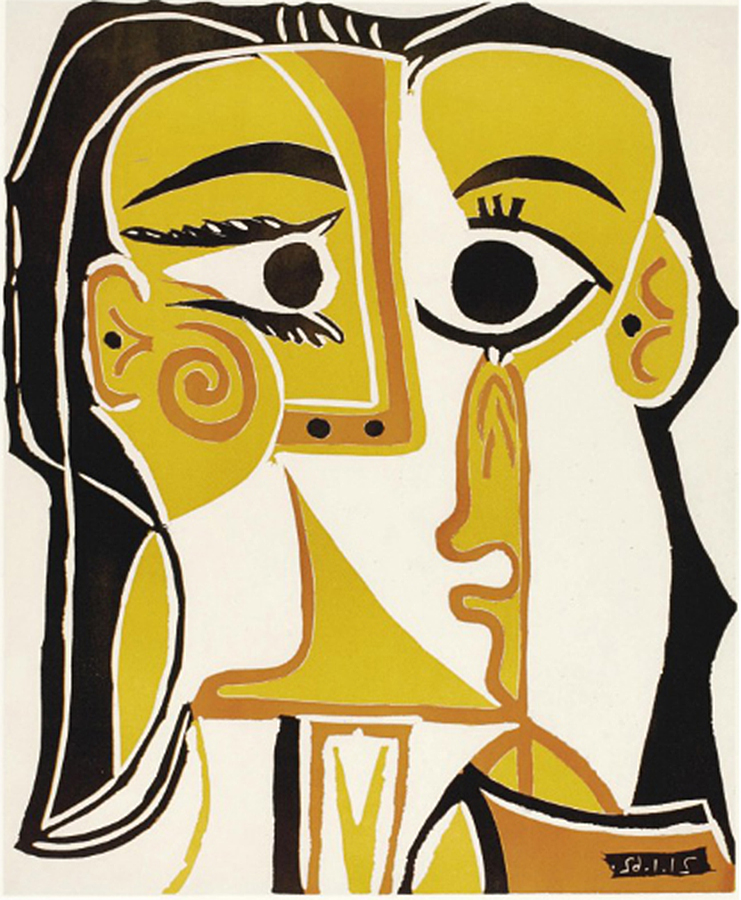
portrait of Jacqueline Roque captured in a cubist style. Jacqueline Roque is Picasso’s second wife and his most prolific muse across his oeuvre. Identified by her long black hair and piercing eyes, Picasso depicts his subject in multiple perspectives. In a close-up view, Picasso frame’s the image so that we see just her head and neck. At first glance, a full-face portrait gazes directly straight-forward. However, upon a closer look, the extreme side profiles of two women who stare at each other, nose to nose emerge. This striking linocut is executed in a bold and fiery palette of black and vibrant yellow and orange. Showcasing the artist’s mastery of line, Picasso switches between using negative and positive space to define the composition. By allowing the pale paper beneath, the artist creates an implied white line which traces the highlights of Jacqueline’s hair and eyelashes and highlights the structure of her face.
Wednesday, March 21, 2018
Pablo Picasso Linoleum Print

This Linoleum Print by Pablo Picasso is very astonishing. The amount of detail and concise line work is unmeasurable. I love how he balances the light with the dark and makes it very clear to distinguish the two. I am also a huge fan of the structure of the phase and how nothing is perfect. Overall, this Linoleum Print is amazing and I wish to research similar ones in the future.
Picador et cheval (Picador and Horse), 1959
Picador et cheval (Picador and Horse), 1959
Picador et cheval, depicts a man gently gripping onto the saddle of his horse. The man in the linocut wears a large hat and pants with round buttons on the side. The horse is lightly sketched with one eye looking at the viewer. It almost looks as if this man is a bullfighter, which Picasso loved and participated in. He pays respect to the man and the horse by carefully sketching the lines that make them up. The lines show certain details that adds charm to the linocut.
The Grape Harvesters
This linocut work by Pablo Picasso is called Les vendangeurs (1959) also known as The Grape Harvesters. I enjoy this piece, because it really shows Picasso's techniques of drawing and color. He used different shades of brown and black to make the curves and lines stand out from the background, emphasizing on the laborers enjoying the grapes after hand-picking them. It is simple and creative, but shows a lot of artistry.
Pablo Picasso Picador et cheval
This linocut made by Pablo Picasso in 1959 was named Picador et cheval, it is a sketch of a Picador and a horse. In Spain bullfighting was very common and Picasso was very into it also. Picasso is showing his general love toward Spain in this work. I really liked this linocut because it is so simple but so detailed at the same time. I love how it looks like a sketch but it is actually a complete detailed piece.
Pablo Picasso: Tête de Femme (Head of Woman)
The abstract color linocut, "Tete de Femme" or "Head of Woman" by Picasso is one I find very interesting. Picasso created this portrait of his second wife in 1962. The colors Picasso chose created good contrast, allowing him to emphasize some of his wife's favorite features including her long black hair and unique eyes. I find this piece to be very interesting especially because at first, it looks as if it is solely a portrait of his wife. Looking at the work from a different perspective, there appears to be two women/girls facing each other from a side profile. Could this be symbolizing Picasso's first and second wife together?
Dancer and the Musician
This piece is called, Danseurs et musicien, (Dancers and Musician) and was created in 1959. There are two dancers an one musician. I love the way Picasso created the whole piece of art. He used many different lines and alternated forms. Picasso made this so that you could be able to feel the music and movement being experienced just by looking at it. This piece is composed of simple lines and forms but when put together it looks so complex and complicated.
Still life with watermelon
Before reading this article I thought of Picasso as a painter. The work he was able to do with linoleum was amazing. All of the works he created were beautiful and represented many different aspects of his life. This piece is called Still Life with Watermelons. I find this piece very nice because it is a still life picture. I find that this picture reminds me of summer and I like the colors he uses, and find this to be a very happy piece of work.
The Grape Harvesters
Pablo Picasso created this print called Les vendangeurs, which meaning "the grape harvesters," in the year 1959. This piece stood out to me mainly because of the contrasting earthy colors and lines throughout the picture. The technique of linocut seems very interesting and I've never heard of it before. Shown above, you see two figures enjoying hand picked grapes while relaxing in a field. It symbolizes their hard work of picking fruits all day and they finally get to kick back and enjoy their hard work as they eat.
Tuesday, March 20, 2018
Les Danseurs au Hibou (Dancers with an Owl)
This piece is called "Les Danseurs au Hibou", or dancers with an owl. I think the way Picasso did linoleum prints was amazing. His work is so intricate and well thought out. I like this piece because the people in it looks like they are having the time of their lives. I also like how they are so many parts of it that differ in shape. He must have spent a lot of time to make sure his work is perfect.
Tete d'Historian
This piece of artwork by Pablo Picasso is called Tete d’Historian,
meaning Head of an Actor. I like this painting because it is really unique. Picasso
was able to use dark tones and obscure shapes to make the painting look very
mysterious. There are many layers seen in the artwork that capture the complexity
of the shapes and lines. By Picasso using dark tones, he is able to catch an
individual’s attention. In the image, the shapes on the face over line each other showing off the textures, highlights, and shadows of the face. Instead
of just using the outside to create the facial features, Picasso uses the inside of the image to do so.
Pablo Picasso, Still Life with Watermelons (Nature morte à la pastèque)
Pablo Picasso, still life with watermelons, 1962 reminds me of a hot summer day but with an aspect of a cool piece of watermelon. This still life represents a bright and cheery summer day. I love summer and warm weather so this artwork spoke out the most to me. The rays of the sun are long which reveal hat it is a very warm day.Also the pattern on the table remind me of a picnic that also represents a nice day to relax and eat outside. I love all the bright colors he chose to use. The border also is very eye catching which ties in the entire picture.
Picador and Torero
"Picador and Torero" by Pablo Picasso
This linocut consists of three colors: brown, black and beige and is 9.5 x 7.75 inches. Its current value is priced at $3,795. The linocut depicts a picador, which is a bull fighter that evades the bull and shows his/her skill by riding and protecting his/her horse. A picador uses a lance to weaken the bull while a torero is a typical bull fighter. I like this image because of the realistic quality of it and I think the contrast between the two roles of these bull fighters was an interesting story to learn.
Toros en Vallauris
This piece, Toros en Vallauris is masterfully created by Pablo Picasso. It is interesting because I always thought of Pablo Picasso as a painter but for many years he created posters using colorful linocut to advertise bullfights, craft exhibitions, and other local art. I think this poster is very interesting because we as the viewers are looking at the bull fight but Picasso separates the man and the bull in half not only by placement but also by color. The faces are also to me a little strange because there are no bodies. I also think this is very fascinating because Pablo Picasso hand signed his name in the bottom right hand corner.
Tê de Femme
This artwork by Pablo Picasso is called, Tê
de Femme (Head of the Woman (1962). I really liked this linocut, because it
really caught my eye. This linocut was a portrait of Jacqueline Roque. The work
is cubist style, and shows Picassos second wife. Picasso framed the picture so
that we just see her head and neck. The artwork looks as if your looking head
on at Picassos wife, but then at a closer look you can see that its really two
side profiles of women who are staring at each other. The two women are nose to
nose. Picasso linocut is executed using bold colors, of black, yellow and
orange. I liked how Picasso incorporated the use of negative and positive space
in his composition. Picasso was able to create Jacqueline’s hair and eyelashes,
using a pale paper to trace the highlights.
Monday, March 19, 2018
Bacchanale au hibou
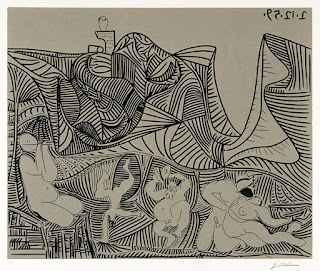
This piece is called, "Bacchanale au hibou" - meaning "Bacchanale with Owl." I thought the idea of linoleum cuts were really cool, especially this one because there are so many intricate cuts involved. These cuts make the piece dynamic and keeps your eye moving. This adds to the idea of depicting a bacchanal. It's also kind of funny that he added an owl to this picture. Usually owls are seen as a contemplative animals and I would like to know why he added it in this scene.
Wednesday, March 14, 2018
Drew
I really like this work done by Drew, most of his sculptures are done in a monochromatic color yet I think so much color and light is in this piece. I really like the branches they look like they can go miles beneath the black wood. This work seems so simple with just different shapes put together yet so complex and large!
Monday, March 12, 2018
Leonard Drew
Leonard Drew is an artist based in Brooklyn New York. He began his art career at a very young age and was featured in his first exhibition at the age of 13. He is known for his work with various materials such as wood, cotton, and mud. In his works he uses oxidation, decay, and burning. I really enjoy Drew's work and how he uses different techniques. I really like this piece and how he used all wood and burned different layers of. I also like how he has the outline of the city at the top of the work.
Drew
Leonardo Drew's work reminds me of the work done by Vik Muniz. Drew talks about working with what already exists similar to Muniz who would make art out of trash. I chose this piece because I like both the color and the texture of it. The top parts resemble cities and sky scrapers, but the texture pops out since the whole piece is in the same color, so the viewer doesn't get lost looking at other details such as color.
Leonardo Drew
Leonardo Drew
Leonardo Drew creates amazing sculptures. He was born in Bridgeport CT and started art when he was young. After an exhibit in high school, he decided that he wanted to be a famous artist. His work truly amazes me. It is so unique and individualized. he pieces that he exhibits are made from things that you wouldn't expect. The This sculpture, labeled Untitled 25, consists of numerous cotton bales can be discussed in terms of his enduring adherence to the minimalist grid. The piece also expresses the intense labor the artist went through to create it as the artist actually made each bale from the cotton batting of mattresses. The cotton bales also evoke America's cotton industry that was built on slave labor.
Wednesday, March 7, 2018
Leonard Drew
Leonardo Drew

This piece called, number 137d, by Leonardo Drew was displayed in 2012. He assembled this piece with both wood and aluminum elements. I like the contrast of these materials in their relative strength and in their colors. I also appreciate the chaos of the elements because they are not organized in their natural setting. Leonardo Drew is known for using elements like cotton, rusted iron, mud, etc. and arranged the elements to propose an architectural challenge. He manipulates these materials through oxidation, decay, and subject to natural elements to display the role of nature.
Leonardo Drew: Number 162
Leonardo Drew is an African-American artist who was raised in Bridgeport, Connecticut, but is currently based in Brooklyn, NY. He began his artistic career at just the age of 13 when he would draw figures from the DC and Marvel comics. Today, he is known for his work that consists of natural earth-made materials made into large sculptures by using processes such as oxidation, burning, and decay. I think some of his work is some of the most creative art I've seen, and what makes it even more beautiful is that it comes from our earth.
Leonardo Drew
Leonardo Drew is an African American artist that grew up in Bridgeport, Connecticut. His very first art was featured when he was just 13 years old. Growing up, he was influenced by other artists such as Normal Rockwell, Maxwell Parrish, and Jackson Pollock. He moved to the city to study art, and he grew so much from there. Many of his works use old and decayed natural items and he regenerates them into new forms of art. These 2 pieces are from a collection of his called "Existed". Drew explains that although the title of this refers to the past, the art itself speaks to the present. It gives off the "I was here" sense and how humans have an urge to leave a trace, just like the old cloths, scavenged objects and trash he used to create these pieces.
Drew
This piece by Leondardo Drew caught my attention mainly because of its size. I cannot believe how large this is and how interesting it is. Drew's art career began during his youth in the inner city of Bridgeport, CT. Memories of his childhood surroundings, such as nearby landfills, inspired him to create artwork such as sculptures made from materials going through the process of decay, oxidation, and exposure to weather. This sculpture reminds me of nature and old pieces of wood. I think this is pretty cool and I admire its huge size.
Leonardo Drew
Leonardo Drew is an artist known for his work of print
making and his exhibit at Pace Prints. Drew uses various mediums from wood, tarps,
binds of nails to a variety of power tools.
Drew got his start at age 13, when he had his first exhibition among his
peers where he commemorated his newspaper photograph. Leonardo Drew was
inspired by different artists like Norman Rockwell, Maxwell Parrish and Jackson
Pollock. I found it interesting that Drew reworks his on pieces and some are
always in a constant state of incompletion. He says that his stuff is just continuing
on and is never unsuccessful. For his
Pace Prints exhibit he starts out by creating works and then making, molds from
that, it’s like making a puzzle and then putting then to a press.
Leonardo Drew
Leonardo Drew creates sculptures
from natural materials, such as wood. He produces his artwork through the
processes of oxidation, burning, and decay. When he’s creating his
masterpieces, Drew is transforming these natural materials into critique social
injustices and the cyclical nature of existence. His sculpture “Existed,” is
built from rows of stacked cotton and wooden boxes, stuffed with rags, covered
with scavenged objects, and covered with rust. This masterpiece is a
representation of the debris of everyday life. I like this sculpture because in
order to make something like this it takes dedication, time, and a great
memory.
Tuesday, March 6, 2018
Leonardo Drew
Leonardo Drew is a contemporary artist based on Brooklyn, New York. This artist particularly interests me because his inspiration began in the town next to mine, Bridgeport CT. He states that he would rummage through the garbage, creating a new meaning to the trash. Drew creates his artwork by using natural materials, oxidation, burning, and decay. This particular piece, 138L, 2015, is made from wood and paint. When researching this particular piece I could not notice how large it was. I have never seen art in such a unique form and it truly is fascinating!
Leonardo Drew
Leonardo Drew is an African American contemporary artist. His works often explore decay and regeneration of natural materials like wood. As a young boy, he was influenced by other artists like Jackson Pollock. Drew's art, through the media it explores, often tells a story. His works also silently boast his carpenter-like abilities. I really like this artwork which is made of wood and paint. It is very simple but somehow draws my attention with the different shapes of wood he uses. It is also ironic that he used wood to make an image of a tree like figure.
Leonardo Drew
"Number 181"
Leonardo Drew uses tree trucks and wood to make his sculptures. His sculptures are usually monochromatic and he forms them through the processes of oxidation, burning and decaying. Leo grew up in a housing project that faced a landfill, a lot of his work is inspired by that. When he was a kid a picture of him and his painting of captain america was in the newspaper this was the very start of his "career". A lot of artist influenced Drew's art but he knew what he wanted to do when he saw Jackson Pollock's work. So far Leo Drew is my favorite artist out of the different artists we have looked at.
Leonardo Drew
Leonardo Drew crafts sculptures and installations out of a mix of found natural and manmade material. These works evoke urban living, humanity's relationship with nature, and African American society. His work is informed by his experience as an African American growing up in a housing project. Urban waste like wooden scraps and objects from condemned housing sites, with tree branches, roots, paper, raw cotton, rust and mud is what makes up his works. He makes these materials into complex and textured forms. Leonardo is known for reworking and recycling his pieces. Keeping some works in a constant state of incompletion.
Leonardo Drew
At Pace Prints, Leonardo Drew works possess a natural earthiness and a deep sense of soul. Leonardo Drew reveals the true beauty in print making. In the article it states "The most rewarding part of being an artist is being challenged, working endless hours consumed by impulses to push limits and attack conventions." This statement truly is shown in his artwork. Leonardo Drew was very hardworking. This artwork in particular has so many different stories that people may interpret. I loved this one out of all of them because the way he interprets nature was really moving to me.
Leonardo Drew
Leonardo Drew crafts sculptures and installations out of a mix of found natural and manmade materials that evoke an urban living, humanity’s relationship with nature, and African American society, among other references. “Take a step back; the truth is right there,” he states, expressing his desire for viewers to engage with his pieces unencumbered by titles or explanations. His work is informed by his experience as an African American growing up in a public housing project. Urban detritus—including wooden scraps and objects from condemned housing and architectural sites, collected by homeless people he pays—figures in his compositions, together with tree branches, roots, paper, raw cotton, rust, and mud. Drew choreographs these materials into complex, textured forms that hold numerous stories.
Leonardo Drew
Leonardo Drew
Leonardo Drew is a contemporary artist based in Brooklyn, New York. He makes sculptures from natural materials using the process of oxidation, decay, and burning. He turns these objects into massive sculptures into pieces of art that critiqued the cyclical nature of existence and social injustices. Many of the materials that Leonardo Drew uses are simple everyday items such as wood, paper, and rope. Since switching to printmaking, Leonardo claims that the only thing that changes is the medium, the art however, is still the same.
Monday, March 5, 2018
Printmaking
https://www.artsy.net/article/artsy-editorial-leonardo-drew-challenges-himself-and-the-traditions-of
Read the article and post images and explain the work of Leonardo Drew.
Read the article and post images and explain the work of Leonardo Drew.
Subscribe to:
Posts (Atom)
